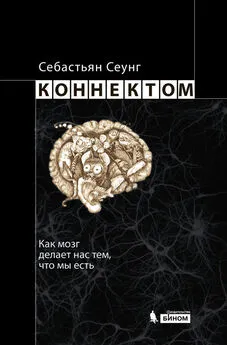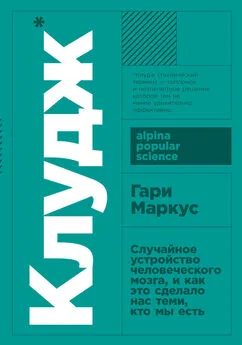Алан Джасанов - Мозг: прошлое и будущее [Что делает нас теми, кто мы есть]
- Название:Мозг: прошлое и будущее [Что делает нас теми, кто мы есть]
- Автор:
- Жанр:
- Издательство:Литагент АСТ
- Год:2019
- Город:Москва
- ISBN:978-5-17-117010-3
- Рейтинг:
- Избранное:Добавить в избранное
-
Отзывы:
-
Ваша оценка:
Алан Джасанов - Мозг: прошлое и будущее [Что делает нас теми, кто мы есть] краткое содержание
Мозг: прошлое и будущее [Что делает нас теми, кто мы есть] - читать онлайн бесплатно ознакомительный отрывок
Интервал:
Закладка:
256
Antonio Damasio, «Descartes Error: Emotion, Reason, and the Human Brain» (New York: G. P. Putnam, 1994).
257
A. R. Damasio, «The somatic marker hypothesis and the possible functions of the prefrontal cortex», «Philosophical Transactions of the Royal Society of London Series B: Biological Sciences» 351 (1996): 1413–1420.
258
B. D. Dunn, T. Dalgleish, and A. D. Lawrence, «The somatic marker hypothesis: A critical evaluation», «Neuroscience & Biobehavioral Reviews» 30 (2006): 239–271.
259
Joseph E. LeDoux, «The Emotional Brain: The Mysterious Underpinnings of Emotional Life» (New York: Simon & Schuster, 1996).
260
Даниэль Канеман. Думай медленно… решай быстро / пер. Школа перевода Баканова. (М.: АСТ, 2014).
261
В статье, опубликованной в 1978 году в журнале «Journal of the American Medical Association» (27: 141–162), Мирон Шоненфельд (Myron Schonenfeld) предположил, что у Паганини, скорее всего, был синдром Марфана, редкое генетическое расстройство.
262
Цит. по: A. Pedrazzini, A. Martelli, and S. Tocco, «Niccolò Paganini: The hands of a genius», «Acta Biomedica» 86 (2015): 27–31.
263
Carl Guhr, «Paganini’s Art of Playing the Violin: With a Treatise on Single and Double Harmonic Notes» , translated by S. Novello (London: Novello & Co., 1915).
264
W. K. Bühler, «Gauss: A Biographical Study» (New York: Springer, 1981).
265
George Lakoff and Rafael E. Núñez, «Where Mathematics Comes From: How the Embodied Mind Brings Mathematics into Being» (New York: Basic Books, 2000).
266
A. D. Wilson and S. Golonka, «Embodied cognition is not what you think it is», «Frontiers in Psychology» 4 (2013): 58.
267
L. M. Gordon et al., «Dental materials: Amorphous intergranular phases control the properties of rodent tooth enamel», «Science» 347 (2015): 746–750.
268
E. N. Woodcock, «Fifty Years a Hunter and a Trapper» (St. Louis: A. R. Harding, 1913).
269
Louise Barrett, «Beyond the Brain: How Body and Environment Shape Animal and Human Minds» (Princeton, NJ: Princeton University Press, 2011).
270
James J. Gibson, «The Theory of Affordances», в кн. «Perceiving, Acting, and Knowing: Toward an Ecological Psychology» , ed. Robert Shaw and John Bransford (Hillsdale, NJ: Lawrence Erlbaum Associates, 1977).
271
Джордж Лакофф, Марк Джонсон. Метафоры, которыми мы живем / пер. А. Баранова, А. Морозовой. (М.: ЛКИ, 2008).
272
A. Eerland, T. M. Guadalupe, and R. A. Zwaan, «Leaning to the left makes the Eiffel Tower seem smaller: Posture-modulated estimation», «Psychological Science» 22 (2011): 1511–1514.
273
L. K. Miles, L. K. Nind, and C. N. Macrae, «Moving through time», «Psychological Science» 21 (2010): 222–223.
274
J. M. Northey, N. Cherbuin, K. L. Pumpa, D. J. Smee, and B. Rattray, «Exercise interventions for cognitive function in adults older than 50: A systematic review with meta-analysis», «British Journal of Sports Medicine» (2017).
275
E. P. Cox et al., «Relationship between physical activity and cognitive function in apparently healthy young to middle-aged adults: A systematic review», «Journal of Science and Medicine in Sport» 19 (2016): 616–628.
276
M. Oppezzo and D. L. Schwartz, «Give your ideas some legs: The positive effect of walking on creative thinking», «Journal of Experimental Psychology: Learning, Memory, and Cognition» 40 (2014): 1142–1152.
277
K. Weigmann, «Why exercise is good for your brain: A closer look at the underlying mechanisms suggests that some sports, especially combined with mental activity, may be more effective than others», «EMBO Reports» 15 (2014): 745–748.
278
Claire Sylvia with William Novak, «A Change of Heart: A Memoir» (New York: Warner Books, 1997).
279
Joe Shute, «The Life-Saving Operations That Change Personalities», «Telegraph» , 6 февраля 2015 года.
280
Will Oremus, «Personality Transplant», «Slate» , 26 марта 2012 года.
281
B. Bunzel, B. Schmidl-Mohl, A. Grundbock, and G. Wollenek, «Does changing the heart mean changing personality? A retrospective inquiry on 47 heart transplant patients», «Quality of Life Research» 1 (1992): 251–256.
282
M. E. Olbrisch, S. M. Benedict, K. Ashe, and J. L. Levenson, «Psychological assessment and care of organ transplant patients», «Journal of Consulting and Clinical Psychology» 70 (2002): 771–783.
283
K. Mattarozzi, L. Cretella, M. Guarino, and A. Stracciari, «Minimal hepatic encephalopathy: Follow-up 10 years after successful liver transplantation», «Transplantation» 93 (2012): 639–643.
284
Michael D. Gershon, «The Second Brain: The Scientific Basis of Gut Instinct and a Groundbreaking New Understanding of Nervous Disorders of the Stomach and Intestine» (New York: HarperCollins, 1998).
285
S. Fass, «Gastric Sleeve Surgery – The Expert’s Guide», Obesity Coverage, obesitycoverage.com, 13 апреля 2017 года.
286
H. Woodberries, «Personality Changes – It’s a Huge Deal!!» Gastric Sleeve Discussion Forum, gastricsleeve.com (10 марта 2012 года).
287
Jeff Seidel, «After Bariatric Surgery, the Rules of Marriage Often Change», «Seattle Times» , 1 июня 2011 года.
288
CDC Newsroom, «Nearly Half a Million Americans Suffered from Clostridium difficile Infections in a Single Year», Centers for Disease Control and Prevention (25 февраля 2015 года).
289
Peter A. Smith, «Can the Bacteria in Your Gut Explain Your Mood?» «New York Times» , 23 июня 2015 года; T. G. Dinan, R. M. Stilling, C. Stanton, and J. F. Cryan, «Collective unconscious: How gut microbes shape human behavior», «Journal of Psychiatric Research» 63 (2015): 1–9.
290
P. Bercik et al., «The intestinal microbiota affect central levels of brain-derived neurotropic factor and behavior in mice», «Gastroenterology» 141 (2011): 599–609.
291
J. A. Bravo et al., «Ingestion of Lactobacillus strain regulates emotional behavior and central GABA receptor expression in a mouse via the vagus nerve», «Proceedings of the National Academy of Sciences» 108 (2011): 16050–16055.
292
K. Tillisch et al., «Consumption of fermented milk product with probiotic modulates brain activity», Gastroenterology 144 (2013): 1394–1401.
293
J. M. Harlow, «Recovery from the passage of an iron bar through the head», «Publication of the Massachusetts Medical Society» 2 (1869): 327–347; A. Bechara, H. Damasio, D. Tranel, and A. R. Damasio, «The Iowa Gambling Task and the somatic marker hypothesis: Some questions and answers», «Trends in Cognitive Science» 9 (2005): 159–162; discussion 62–64.
294
J. Horgan, «The forgotten era of brain chips», «Scientific American» 293 (2005): 66–73.
295
J. Gorman, «Brain Control in a Flash of Light», «New York Times» , 21 апреля 2014 года.
296
W. R. Lovallo et al., «Caffeine stimulation of cortisol secretion across the waking hours in relation to caffeine intake levels», «Psychosomatic Medicine» 67 (2005): 734–739; J. R. Schwartz and T. Roth, «Neurophysiology of sleep and wakefulness: Basic science and clinical implications», «Current Neuropharmacology» 6 (2008): 367–378.
297
Отсылка к стихотворению английского поэта Джона Донна (1572–1631) «No man is an island». – Прим. ред.
298
Peter M. Milner, «The Autonomous Brain: A Neural Theory of Attention and Learning» (Mahwah, NJ: Lawrence Erlbaum, 1999).
299
P. Haggard, «Human volition: Towards a neuroscience of will», «Nature Reviews Neuroscience» 9 (2008): 934–946.
300
B. Libet, C. A. Gleason, E. W. Wright, and D. K. Pearl, «Time of conscious intention to act in relation to onset of cerebral activity (readiness-potential): The unconscious initiation of a freely voluntary act», «Brain» 106 (Part 3) (1983): 623–642.
301
David Eagleman, «Incognito: The Secret Lives of the Brain» (New York: Vintage Books, 2012).
302
«Головоломка» , режиссеры Пит Доктер и Рональдо Дель Кармен (Walt Disney Studios, 2015).
303
Гилберт Райл. Понятие сознания. (М.: Идея-Пресс, 2000).
304
Артур Шопенгауэр. Конкурсное сочинение «О свободе воли» // А. Шопенгауэр. Собрание сочинений: В 6 т. Т. 3. Малые философские сочинения / пер. под ред. А. Чанышева. (М.: ТЕРРА, 2001).
305
«Fodor’s Tokyo» , ed. Stephanie E. Butler (New York: Random House, 2011).
306
Three-Monkeys, three-monkeys.info.
307
Juhi Saklani, «Eyewitness Gandhi» (New York: DK Publishing, 2014).
308
Neil Strauss, «Mafia Songs Break a Code of Silence; A Gory Italian Folk Form Attracts Fans, and Critics», «New York Times» , 22 июля 2002 года.
309
«The Bhagavad Gita» , translated by Laurie L. Patton. (New York: Penguin Classics, 2008).
310
H. B. Barlow, W. R. Levick, and M. Yoon, «Responses to single quanta of light in retinal ganglion cells of the cat», «Vision Research», Suppl 3 (1971): 87–101.
311
M. Meister, R. O. Wong, D. A. Baylor, and C. J. Shatz, «Synchronous bursts of action potentials in ganglion cells of the developing mammalian retina», «Science» 252 (1991): 939–943.
Читать дальшеИнтервал:
Закладка:
![Обложка книги Алан Джасанов - Мозг: прошлое и будущее [Что делает нас теми, кто мы есть]](/books/1070785/alan-dzhasanov-mozg-proshloe-i-buduchee-chto-delaet.webp)







